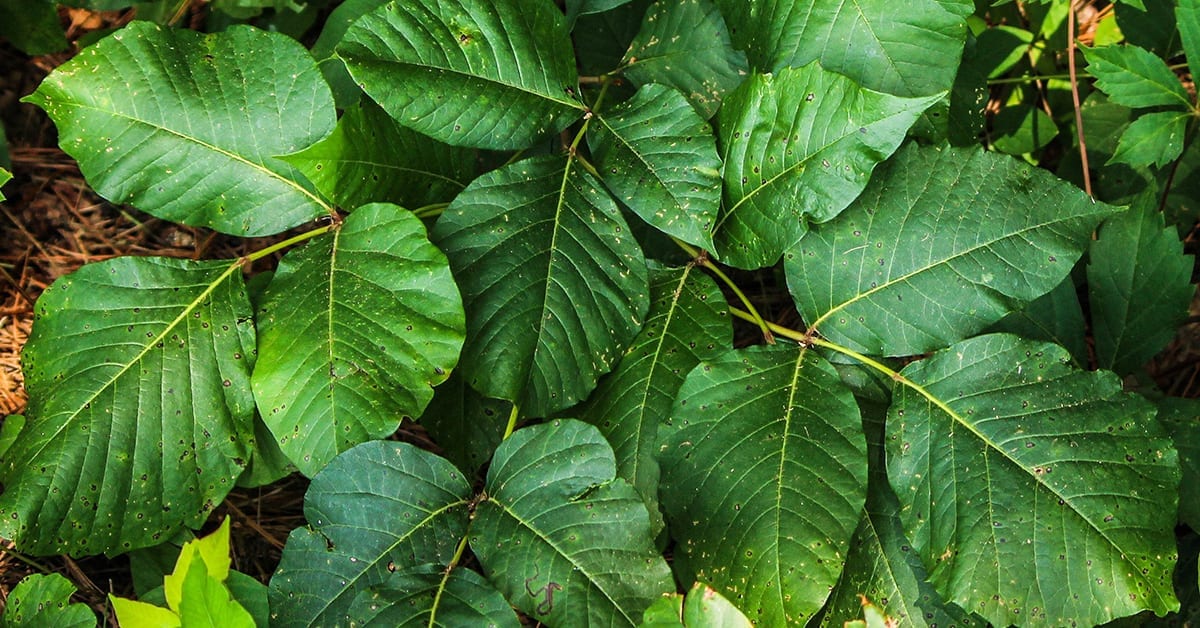
Don’t let poison ivy ruin your summer—learn how to identify, treat and avoid it all year round.
I don’t want to overstate this, but poison ivy is the worst thing growing on Planet Earth. Too harsh an assessment? Maybe. But as far as summertime problems go, a bad case of poison ivy tops my list—behind a horrible sunburn and chigger bites. That being said, it’s important to know the misconceptions about the plant and how to keep yourself safe from it this summer and year round.
What makes poison ivy so poisonous?
First and foremost, you need to know that the “stuff” that makes a poison ivy plant so miserable is called urushiol. This is the oil that elicits the scratchy rash that those of us who’ve come to know and hate the Devil Plant remember so well. Urushiol is present in the toxicodendron family of plants and is found on the leaves, in the stems, the roots and even the berries of the plants. Poison ivy (Toxicodendron radicans and toxicodendron rydbergii), poison oak (Toxicodendron diversilobum and toxicodendron pubescens), and poison sumac (toxicodendron vernix) plants all produce urushiol; you won’t be able to differentiate the specific plant you brushed up against by the rash it produces. But here’s the thing—it doesn’t really matter. Each of these three plants all make urushiol, and it’s the urushiol that makes you miserable. In the interest of keeping you not miserable, here are some common things to know about poison ivy and how to treat it if you’re unlucky enough to come across some.
Where does poison ivy grow?
If you are curious about the offending ivy, oak or sumac, pay attention to where in North America you are. In the Midwest, it’s fairly unlikely you’ll run into the oak or sumac; poison oak’s growing distribution is in the western United States, and it really isn’t found east of the Rocky Mountains. Poison sumac tends to be more concentrated in the southeastern United States but can be found in the northeast part of the country as well as around the Great Lakes areas.
How does poison ivy spread?
Most of the time when people come into contact with poison ivy, oak or sumac, they simply brush up against the plant, the urushiol gets on their skin, and a few days later they notice themselves scratching a rash; unfortunately, this isn’t the only way urushiol spreads from person to person.
Urushiol can transfer from the plant to something that a person then touches. For example, urushiol is oftentimes transferred from pets: Your dog walks through poison ivy, gets urushiol on its fur, you pet the dog, you get poison ivy. Picking up somebody else’s gardening gloves who has been working in poison ivy can get you a rash. Woe to the poor gentleman who walks through poison ivy, gets urushiol all over his shoelaces and stops to tie his shoes—and then decides to go to the bathroom. As soon as urushiol touches the skin, it begins to penetrate and is completely bound within eight hours. If it’s been less than eight hours, urushiol can be alleviated with soap and water, but if it’s been more than that (or sooner if it’s particularly thin skin), your fate is likely sealed—washing with soap and water is very unlikely to help after a few hours.
The amazing thing about urushiol is that it can remain allergenic on clothing for up to 10 years! That’s right—you can get urushiol on your jeans, put them in a drawer and pull them out years later and still get a blistering rash from the leftover urushiol. For outdoor-lovers, it’s important to always remember to wash your equipment after camping or backpacking trips; it’s easy to come in contact with poison ivy and get oil all over sleeping bags, tents, packs, boots and clothing. Thoroughly washing your gear year-over-year will help make sure residual urushiol doesn’t affect your next outdoor excursion.
On top of being capable of lasting the better part of a decade, urushiol is also extremely heat tolerant. Fire doesn’t break it down, it simply releases the toxins into the air; so, and this is very important, NEVER, EVER burn poison ivy. Aerosolizing the compound and breathing it in shifts symptoms from miserable rash into several
nights in a hospital.
How long does poison ivy last?
A particularly cruel aspect of poison ivy is that the rash can take anywhere from 24 hours to seven days to develop. This leads to the misconception that the rash “spreads.” The timing with which poison ivy symptoms erupt depends on three things:
- The amount of urushiol involved
- The thickness of the skin involved
- The sensitivity of the person exposed
Let’s say somebody gets into a big patch of poison ivy and doesn’t know it. A great deal of the urushiol gets on the thinner skin of the wrists and undersides of the forearms. A little bit less gets on the thicker skin over the knee caps. The rash will start to develop first on the wrists and undersides of the forearms and a few days later may erupt on the knees.
This gives the impression that the rash is spreading when in reality, it’s not spreading, it just hasn’t fully erupted. This also has given way to the misconception that a weeping poison ivy rash is contagious. It is not. Fluid from poison ivy blisters does not contain urushiol and cannot cause a rash. The rash doesn’t spread; it just erupts at different times based on the amount of urushiol, the thickness of the skin, and where it spreads when you rub or scratch your skin. It is possible, however, that urushiol could still be present on another piece of clothing, causing more rash to pop up . In either case, the takeaway is that one exposure to urushiol causes one rash, which may develop over the body at different rates.
The other factor that affects rash timing is the sensitivity of the person involved. Not everybody has a poison ivy sensitivity, but make no mistake, you can absolutely develop one at any time. Many people have made the claim that they are immune to poison ivy only to find out later, even at ages 50 and 60, that they have developed a horrible reaction to it. You may not be allergic to it now, but understand that can change over time.
What does poison ivy look like? Obey the "Hands-Off" rule!
The best way to avoid poison ivy is to try and avoid the plant altogether. The basic rule for both poison ivy and poison oak, is “Leaves of Three, Leave Them Be.” A three-leaved plant isn’t anything you want to mess with. The leaves can occasionally take on a shiny appearance. Poison ivy turns a very red, vibrant color in the fall and
is rather pretty. It also is very important to note that poison ivy can be a plant, a shrub or an ivy-like vine, so don’t be fooled by its various forms.
Another way to identify a poison ivy plant is by observing what sort of light is in the area. Poison ivy likes semi-shade. This isn’t absolute, but in full sun and in the deep woods, you can relax a bit; where you really need to be paying attention is on the edge of the forest and, particularly, along the edges of bike paths. That little break in the trees provides just enough sun for poison ivy to thrive.


Poison ivy as a plant
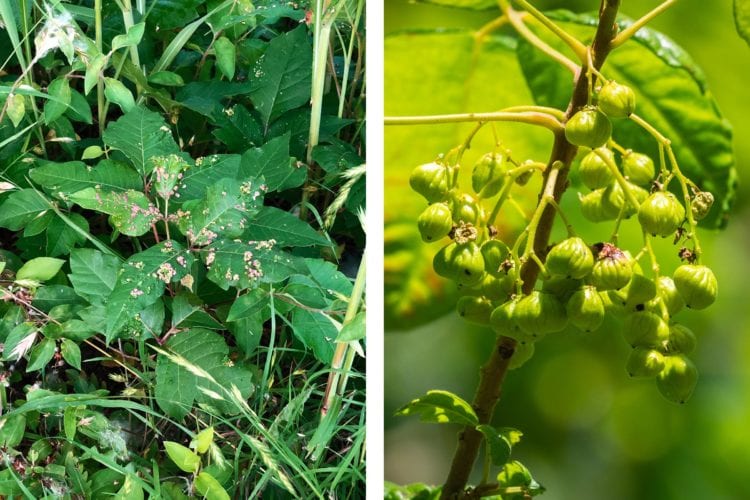
Poison ivy as a woody shrub – note the woody stem and the green berries.
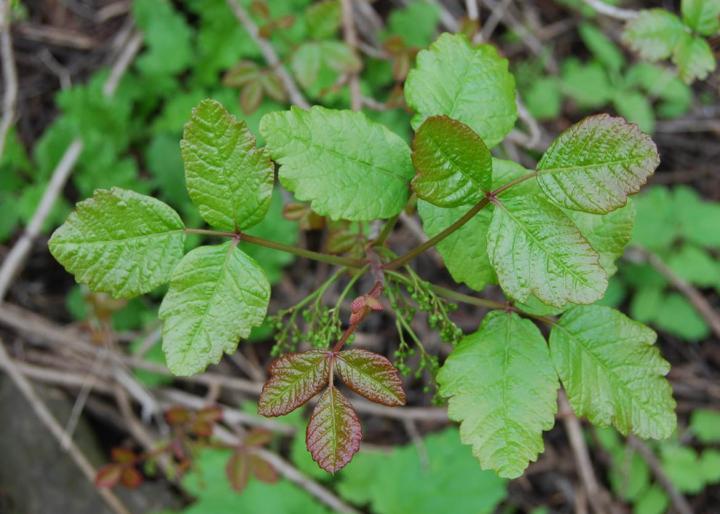
Poison oak. Note the lobed appearance of the leaves. Again, this isn’t any worse than poison ivy in terms of rash. Urushiol is urushiol.
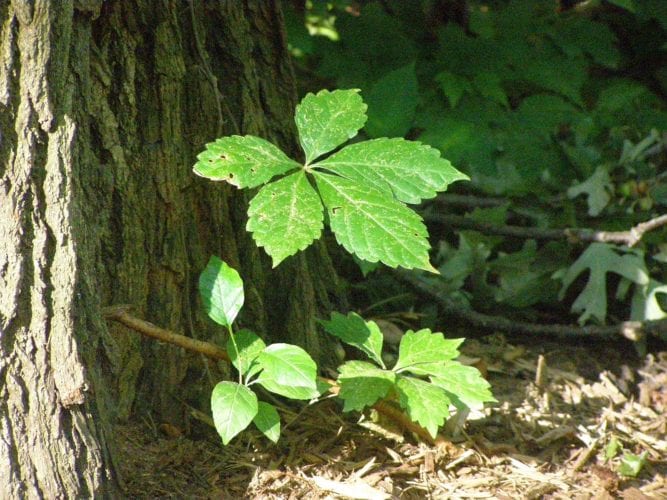
This looks scary, but it isn’t. This is Virginia creeper. Note the five leaves instead of the three. You don’t have to worry about this one. It’s a friend.
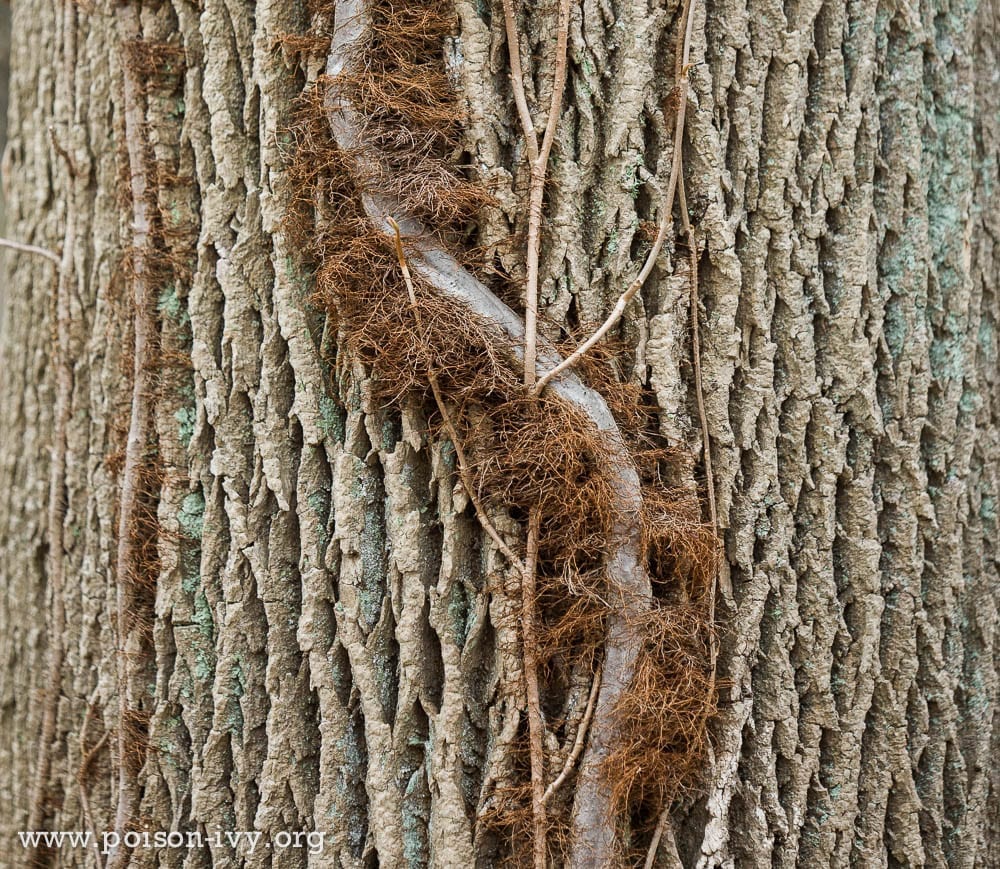
Be very, very careful of a vine that looks like this. This is poison ivy in the winter and you can absolutely get a rash by trying to take it down. Even during the wintertime, it’s still cranking out urushiol.
Great, I've got it, now what? How to treat poison ivy
Well, firstly, I’m awfully sorry, and for what it’s worth, I feel your pain. The first thing to do is to make sure you wash all your clothes, towels, sheets, especially your shoelaces and anything else that you might have handled that could still have urushiol on it to avoid getting any more on your skin.
If you want to, you don’t have to do anything. A poison ivy rash is miserable, but it isn’t life-threatening; scratching a poison ivy rash won't kill you, but it will continue spreading urushiol if you're not careful. If you want to wait it out, that’s fine. If you do want to treat it, skip the home remedies for poison ivy and go see your doctor. It’s unlikely that over-the-counter steroid creams are going to have the potency necessary to improve symptoms. You can also skip the Benadryl. It might help you sleep because it makes you drowsy, but Benadryl works on something other than what is actually causing the rash.
If the case is bad enough, your doctor might prescribe systemic steroids. It’s important to note that there is no difference in the bioavailability of a shot versus pills; in other words, the pills work just as well as a shot. Now, that said, don’t take just any Prednisone you have lying around at home. If you don’t take a systemic steroid for long enough, you can get what’s called a rebound reaction, which is when the rash comes back worse and more awful than before. There’s nothing to do about that; if you get a rebound rash, you’re completely out of luck.
It's in my backyard, what do I do? How to kill poison ivy
I think you should. Go crazy. Personally, I’d break out the Roundup because I can’t think of a worse way to get a case of poison ivy than by pulling it. If you do decide to pull it, throw your gloves away afterward. Poison ivy is a perennial, so it’ll come back year-after-year, but if you thought you caught it all and then more shows up, blame your birds. They’ll oftentimes bring seeds back and replant it. Above all, DON’T BURN IT (remember?).
If you do have a massive patch and don’t want to scorch the earth with Roundup, there’s another solution. Goats. No, seriously, goats. There are services that will bring goats to your property and the goats go in and mow it down. Obviously, this comes at considerable expense, but if you’re looking for an organic solution that doesn’t involve you getting down on your hands and knees in a massive patch of poison ivy and pulling it out (which I would never do for all the money in the world), this is it.
So that’s a breakdown of the most evil plant that’s ever been seen on the face of the Earth. It shouldn’t keep you inside during the summer, it should just remind you to pay close attention to where you’re walking.
The expert family medicine providers at the Des Moines University Clinic can help you and your loved ones stay healthy this summer and beyond. For more information or to make an appointment, visit the DMU Clinic website or call 515-271-1710.





